
EBK PRINCIPLES OF AUDITING & OTHER ASSU
21st Edition
ISBN: 9781260299434
Author: WHITTINGTON
Publisher: YUZU
expand_more
expand_more
format_list_bulleted
Question
Chapter 7, Problem 35COQ
To determine
Identify the appropriate answer related to the primary objective of the
Expert Solution & Answer
Want to see the full answer?
Check out a sample textbook solution
Students have asked these similar questions
Provide Answer
Can you demonstrate the accurate steps for solving this financial accounting problem with valid procedures?
What was the net cash flow provided by opening activities for horizon industries?
Chapter 7 Solutions
EBK PRINCIPLES OF AUDITING & OTHER ASSU
Ch. 7 - Prob. 1RQCh. 7 - Prob. 2RQCh. 7 - Prob. 3RQCh. 7 - Prob. 4RQCh. 7 - Prob. 5RQCh. 7 - Prob. 6RQCh. 7 - Prob. 7RQCh. 7 - Identify the four types of control activities and...Ch. 7 - One basic concept of internal control is that no...Ch. 7 - Prob. 10RQ
Ch. 7 - Prob. 11RQCh. 7 - Prob. 12RQCh. 7 - Prob. 13RQCh. 7 - Prob. 14RQCh. 7 - Prob. 15RQCh. 7 - Prob. 16RQCh. 7 - Prob. 17RQCh. 7 - Prob. 18RQCh. 7 - Prob. 19RQCh. 7 - Prob. 20RQCh. 7 - Prob. 21RQCh. 7 - Prob. 22RQCh. 7 - Prob. 23RQCh. 7 - Management is responsible for designing and...Ch. 7 - Prob. 25QRACh. 7 - Prob. 26QRACh. 7 - Prob. 27QRACh. 7 - Prob. 28QRACh. 7 - Prob. 29QRACh. 7 - Prob. 30QRACh. 7 - Prob. 31QRACh. 7 - During your first audit of a medium-size...Ch. 7 - Prob. 33QRACh. 7 - Prob. 34QRACh. 7 - Which of the following would be least likely to be...Ch. 7 - Prob. 35BOQCh. 7 - Prob. 35COQCh. 7 - Prob. 35DOQCh. 7 - Prob. 35EOQCh. 7 - Prob. 35FOQCh. 7 - Prob. 35GOQCh. 7 - Prob. 35HOQCh. 7 - Which of the following is not an advantage of...Ch. 7 - Prob. 35JOQCh. 7 - Prob. 35KOQCh. 7 - Prob. 35LOQCh. 7 - Prob. 36OQCh. 7 - Listed below are controls that have been developed...Ch. 7 - Prob. 38OQCh. 7 - For each term in the first column, find the...Ch. 7 - Prob. 40AOQCh. 7 - Prob. 40BOQCh. 7 - Prob. 40COQCh. 7 - Prob. 40DOQCh. 7 - Prob. 40EOQCh. 7 - Prob. 41PCh. 7 - Prob. 42PCh. 7 - Prob. 43PCh. 7 - Prob. 44PCh. 7 - Prob. 45ITC
Knowledge Booster
Similar questions
- Blue Oak, Inc., uses direct labor hours to allocate overhead costs. If Blue Oak estimates $60,000 of overhead and 75,000 hours of direct labor this period, the overhead applied when 6,000 direct labor hours are used should be_____. a. $4,200.33 b. $4,800.00 c. $5,125.48 d. $5,865.75arrow_forwardGiven answer with step by step calculationarrow_forwardCan you guide me through solving this financial accounting problem using proper techniques?arrow_forward
arrow_back_ios
SEE MORE QUESTIONS
arrow_forward_ios
Recommended textbooks for you
 Auditing: A Risk Based-Approach to Conducting a Q...AccountingISBN:9781305080577Author:Karla M Johnstone, Audrey A. Gramling, Larry E. RittenbergPublisher:South-Western College Pub
Auditing: A Risk Based-Approach to Conducting a Q...AccountingISBN:9781305080577Author:Karla M Johnstone, Audrey A. Gramling, Larry E. RittenbergPublisher:South-Western College Pub Auditing: A Risk Based-Approach (MindTap Course L...AccountingISBN:9781337619455Author:Karla M Johnstone, Audrey A. Gramling, Larry E. RittenbergPublisher:Cengage Learning
Auditing: A Risk Based-Approach (MindTap Course L...AccountingISBN:9781337619455Author:Karla M Johnstone, Audrey A. Gramling, Larry E. RittenbergPublisher:Cengage Learning Accounting Information SystemsAccountingISBN:9781337619202Author:Hall, James A.Publisher:Cengage Learning,
Accounting Information SystemsAccountingISBN:9781337619202Author:Hall, James A.Publisher:Cengage Learning,- Business/Professional Ethics Directors/Executives...AccountingISBN:9781337485913Author:BROOKSPublisher:Cengage

Auditing: A Risk Based-Approach to Conducting a Q...
Accounting
ISBN:9781305080577
Author:Karla M Johnstone, Audrey A. Gramling, Larry E. Rittenberg
Publisher:South-Western College Pub

Auditing: A Risk Based-Approach (MindTap Course L...
Accounting
ISBN:9781337619455
Author:Karla M Johnstone, Audrey A. Gramling, Larry E. Rittenberg
Publisher:Cengage Learning

Accounting Information Systems
Accounting
ISBN:9781337619202
Author:Hall, James A.
Publisher:Cengage Learning,


Business/Professional Ethics Directors/Executives...
Accounting
ISBN:9781337485913
Author:BROOKS
Publisher:Cengage